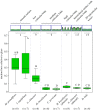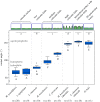Plant surfaces with cuticular folds are slippery for beetles
- PMID: 21642366
- PMCID: PMC3223627
- DOI: 10.1098/rsif.2011.0202
Plant surfaces with cuticular folds are slippery for beetles
Abstract
Plant surfaces covered with three-dimensional (3D) waxes are known to strongly reduce insect adhesion, leading to slippery surfaces. Besides 3D epicuticular waxes, cuticular folds are a common microstructure found on plant surfaces, which have not been quantitatively investigated with regard to their influence on insect adhesion. We performed traction experiments with Colorado potato beetles on five plant surfaces with cuticular folds of different magnitude. For comparison, we also tested (i) smooth plant surfaces and (ii) plant surfaces possessing 3D epicuticular waxes. Traction forces on surfaces with medium cuticular folds, of about 0.5 µm in both height and thickness and a spacing of 0.5-1.5 µm, were reduced by an average of 88 per cent in comparison to smooth plant surfaces. Traction forces were reduced by the same order of magnitude as on plant surfaces covered with 3D epicuticular waxes. For surface characterization, we performed static contact angle measurements, which proved a strong effect of cuticular folds also on surface wettability. Surfaces possessing cuticular folds of greater magnitude showed higher contact angles up to superhydrophobicity. We hypothesize that cuticular folds reduce insect adhesion mainly due to a critical roughness, reducing the real contact area between the surface and the insect's adhesive devices.
Figures





References
-
- Barthlott W., Neinhuis C., Cutler D., Ditsch F., Meusel I., Theisen I., Wilhelmi H. 1998. Classification and terminology of plant epicuticular waxes. Bot. J. Linnean Soc. 126, 237–26010.1111/j.1095-8339.1998.tb02529.x (doi:10.1111/j.1095-8339.1998.tb02529.x) - DOI - DOI
-
- Koch K., Bhushan B., Barthlott W. 2008. Diversity of structure, morphology and wetting of plant surfaces. Soft Matter 4, 1943–196310.1039/b804854a (doi:10.1039/b804854a) - DOI - DOI
-
- Barthlott W., Ehler N. 1977. Raster-Elektronenmikroskopie der Epidermis-Oberflächen von Spermatophyten. Tropische und Subtropische Pflanzenwelt 19, 105
-
- Gorb S. 2001. Attachment devices of insect cuticle. Dordrecht, The Netherlands: Kluwer Academic Publishers
-
- Federle W., Rohrseitz K., Holldobler B. 2000. Attachment forces of ants measured with a centrifuge: better ‘wax-runners’ have a poorer attachment to a smooth surface. J. Exp. Biol. 203, 505–512 - PubMed
Publication types
MeSH terms
LinkOut - more resources
Full Text Sources
Other Literature Sources

